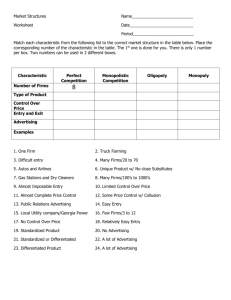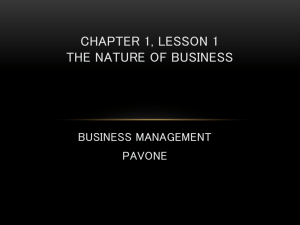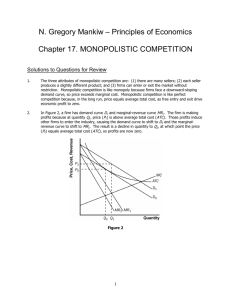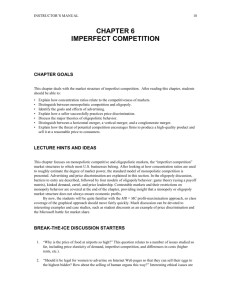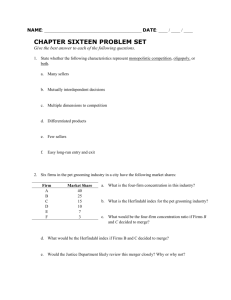File
advertisement
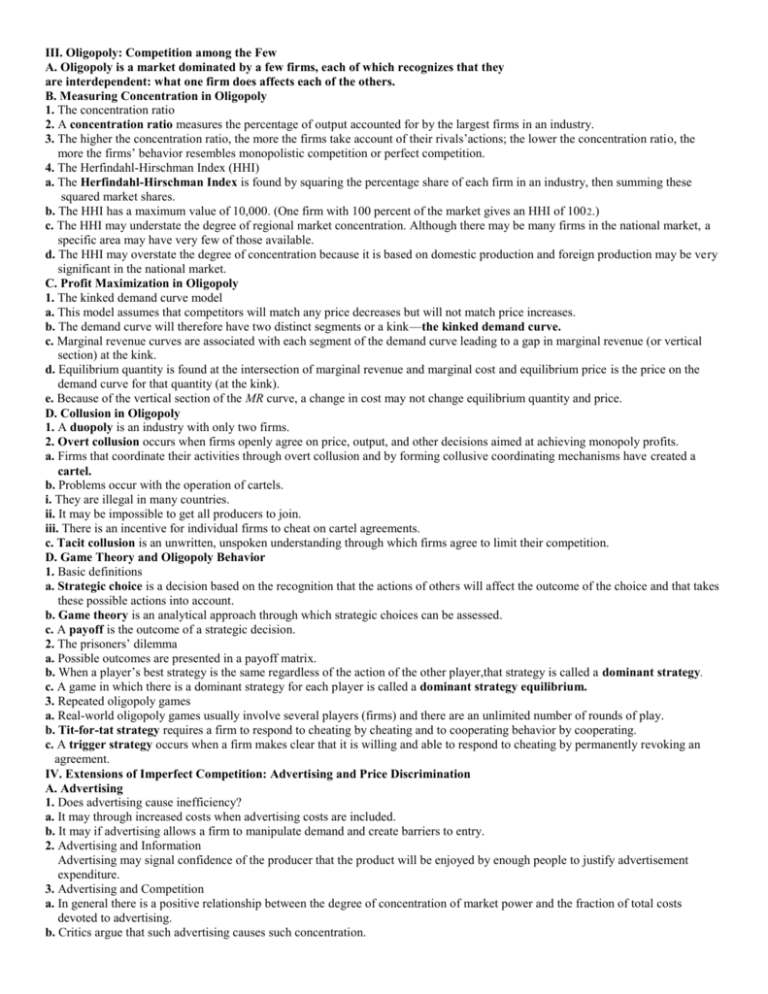
III. Oligopoly: Competition among the Few A. Oligopoly is a market dominated by a few firms, each of which recognizes that they are interdependent: what one firm does affects each of the others. B. Measuring Concentration in Oligopoly 1. The concentration ratio 2. A concentration ratio measures the percentage of output accounted for by the largest firms in an industry. 3. The higher the concentration ratio, the more the firms take account of their rivals’actions; the lower the concentration ratio, the more the firms’ behavior resembles monopolistic competition or perfect competition. 4. The Herfindahl-Hirschman Index (HHI) a. The Herfindahl-Hirschman Index is found by squaring the percentage share of each firm in an industry, then summing these squared market shares. b. The HHI has a maximum value of 10,000. (One firm with 100 percent of the market gives an HHI of 100 2.) c. The HHI may understate the degree of regional market concentration. Although there may be many firms in the national market, a specific area may have very few of those available. d. The HHI may overstate the degree of concentration because it is based on domestic production and foreign production may be very significant in the national market. C. Profit Maximization in Oligopoly 1. The kinked demand curve model a. This model assumes that competitors will match any price decreases but will not match price increases. b. The demand curve will therefore have two distinct segments or a kink—the kinked demand curve. c. Marginal revenue curves are associated with each segment of the demand curve leading to a gap in marginal revenue (or vertical section) at the kink. d. Equilibrium quantity is found at the intersection of marginal revenue and marginal cost and equilibrium price is the price on the demand curve for that quantity (at the kink). e. Because of the vertical section of the MR curve, a change in cost may not change equilibrium quantity and price. D. Collusion in Oligopoly 1. A duopoly is an industry with only two firms. 2. Overt collusion occurs when firms openly agree on price, output, and other decisions aimed at achieving monopoly profits. a. Firms that coordinate their activities through overt collusion and by forming collusive coordinating mechanisms have created a cartel. b. Problems occur with the operation of cartels. i. They are illegal in many countries. ii. It may be impossible to get all producers to join. iii. There is an incentive for individual firms to cheat on cartel agreements. c. Tacit collusion is an unwritten, unspoken understanding through which firms agree to limit their competition. D. Game Theory and Oligopoly Behavior 1. Basic definitions a. Strategic choice is a decision based on the recognition that the actions of others will affect the outcome of the choice and that takes these possible actions into account. b. Game theory is an analytical approach through which strategic choices can be assessed. c. A payoff is the outcome of a strategic decision. 2. The prisoners’ dilemma a. Possible outcomes are presented in a payoff matrix. b. When a player’s best strategy is the same regardless of the action of the other player,that strategy is called a dominant strategy. c. A game in which there is a dominant strategy for each player is called a dominant strategy equilibrium. 3. Repeated oligopoly games a. Real-world oligopoly games usually involve several players (firms) and there are an unlimited number of rounds of play. b. Tit-for-tat strategy requires a firm to respond to cheating by cheating and to cooperating behavior by cooperating. c. A trigger strategy occurs when a firm makes clear that it is willing and able to respond to cheating by permanently revoking an agreement. IV. Extensions of Imperfect Competition: Advertising and Price Discrimination A. Advertising 1. Does advertising cause inefficiency? a. It may through increased costs when advertising costs are included. b. It may if advertising allows a firm to manipulate demand and create barriers to entry. 2. Advertising and Information Advertising may signal confidence of the producer that the product will be enjoyed by enough people to justify advertisement expenditure. 3. Advertising and Competition a. In general there is a positive relationship between the degree of concentration of market power and the fraction of total costs devoted to advertising. b. Critics argue that such advertising causes such concentration. c. Advertising may, though, encourage price competition. d. Advertising may provide a new product with a possibility of success on the market thereby increasing competition. B. Price Discrimination 1. Price discrimination occurs when a firm charges different prices for the same good or service to different consumers even though there is no difference in the cost to the firm of supply. 2. There are three required conditions for price discrimination. a. There must be a price-setting firm. b. There must be distinguishable customers. c. There must be some means to keep the market segments separate in order for the prevention of resale. 3. Price discrimination allows the firm to take advantage of different price elasticities of demand among potential customers thereby maximizing profits.
